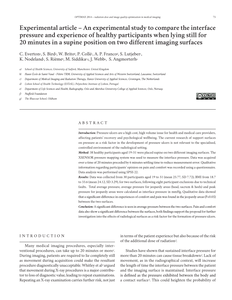Introduction: Pressure ulcers are a high cost, high volume issue for health and medical care providers, affecting patients’ recovery and psychological wellbeing. The current research of support surfaces on pressure as a risk factor in the development of pressure ulcers is not relevant to the specialised, controlled environment of the radiological setting. Method: 38 healthy participants aged 19-51 were placed supine on two different imaging surfaces. The XSENSOR pressure mapping system was used to measure the interface pressure. Data was acquired over a time of 20 minutes preceded by 6 minutes settling time to reduce measurement error. Qualitative information regarding participants’ opinion on pain and comfort was recorded using a questionnaire. Data analysis was performed using SPSS 22. Results: Data was collected from 30 participants aged 19 to 51 (mean 25.77, SD 7.72), BMI from 18.7 to 33.6 (mean 24.12, SD 3.29), for two surfaces, following eight participant exclusions due to technical faults. Total average pressure, average pressure for jeopardy areas (head, sacrum & heels) and peak pressure for jeopardy areas were calculated as interface pressure in mmHg. Qualitative data showed that a significant difference in experiences of comfort and pain was found in the jeopardy areas (P<0.05) between the two surfaces. Conclusion: A significant difference is seen in average pressure between the two surfaces. Pain and comfort data also show a significant difference between the surfaces, both findings support the proposal for further investigation into the effects of radiological surfaces as a risk factor for the formation of pressure ulcers.
DOCUMENT

INTRODUCTION: While prone positioning (PP) has been shown to improve patient survival in moderate to severe acute respiratory distress syndrome (ARDS) patients, the rate of application of PP in clinical practice still appears low.AIM: This study aimed to determine the prevalence of use of PP in ARDS patients (primary endpoint), the physiological effects of PP, and the reasons for not using it (secondary endpoints).METHODS: The APRONET study was a prospective international 1-day prevalence study performed four times in April, July, and October 2016 and January 2017. On each study day, investigators in each ICU had to screen every patient. For patients with ARDS, use of PP, gas exchange, ventilator settings and plateau pressure (Pplat) were recorded before and at the end of the PP session. Complications of PP and reasons for not using PP were also documented. Values are presented as median (1st-3rd quartiles).RESULTS: Over the study period, 6723 patients were screened in 141 ICUs from 20 countries (77% of the ICUs were European), of whom 735 had ARDS and were analyzed. Overall 101 ARDS patients had at least one session of PP (13.7%), with no differences among the 4 study days. The rate of PP use was 5.9% (11/187), 10.3% (41/399) and 32.9% (49/149) in mild, moderate and severe ARDS, respectively (P = 0.0001). The duration of the first PP session was 18 (16-23) hours. Measured with the patient in the supine position before and at the end of the first PP session, PaO2/FIO2 increased from 101 (76-136) to 171 (118-220) mmHg (P = 0.0001) driving pressure decreased from 14 [11-17] to 13 [10-16] cmH2O (P = 0.001), and Pplat decreased from 26 [23-29] to 25 [23-28] cmH2O (P = 0.04). The most prevalent reason for not using PP (64.3%) was that hypoxemia was not considered sufficiently severe. Complications were reported in 12 patients (11.9%) in whom PP was used (pressure sores in five, hypoxemia in two, endotracheal tube-related in two ocular in two, and a transient increase in intracranial pressure in one).CONCLUSIONS: In conclusion, this prospective international prevalence study found that PP was used in 32.9% of patients with severe ARDS, and was associated with low complication rates, significant increase in oxygenation and a significant decrease in driving pressure.
DOCUMENT
To date, it is unknown whether waist circumference can be measured validly and reliably when a subject is in a supine position. This issue is relevant when international standards for healthy participants are applied to persons with severe intellectual, sensory, and motor disabilities. Thus, the aims of our study were (1) to determine the validity of waist circumference measurements obtained in a supine position, (2) to formulate an equation that predicts standing waist circumference from measurements obtained in a supine position, and (3) to determine the reliability of measuring waist circumference in persons with severe intellectual, sensory, and motor disabilities. First, we performed a validity study in 160 healthy participants, in which we compared waist circumference obtained in standing and supine positions. We also conducted a test-retest study in 43 participants with severe intellectual, sensory, and motor disabilities, in which we measured the waist circumference with participants in the supine position. Validity was assessed with paired t-test and Wilcoxon signed rank test. A prediction equation was estimated with multiple regression analysis. Reliability was assessed by Wilcoxon signed rank test, limits of agreement (LOA), and intraclass correlation coefficients (ICC). Paired t-test and Wilcoxon signed rank test revealed significant differences between standing and supine waist circumference measurements. We formulated an equation to predict waist circumference (R(2)=0.964, p<0.001). There were no significant differences between test and retest waist circumference values in disabled participants (p=0.208; Wilcoxon signed rank test). The LOA was 6.36 cm, indicating a considerable natural variation at the individual level. ICC was .98 (p<0.001). We found that the validity of supine waist circumference is biased towards higher values (1.5 cm) of standing waist circumference. However, standing waist circumference can be predicted from supine measurements using a simple prediction equation. This equation allows the comparison of supine measurements of disabled persons with the international standards. Supine waist circumference can be reliably measured in participants with severe intellectual, sensory, and motor disabilities.
DOCUMENT